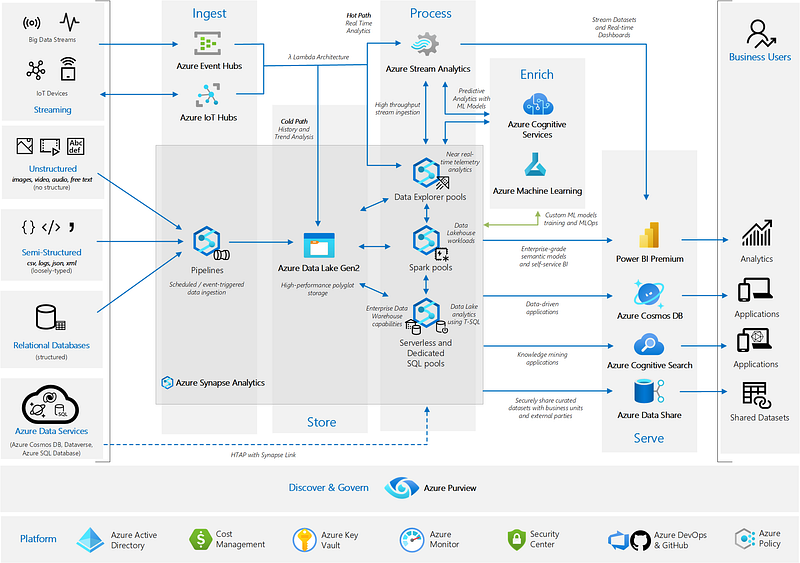Building a Robust Data Mesh on Microsoft Azure: A Comprehensive Guide
Written on
Understanding the Data Mesh Concept
The emergence of Data Lakehouses and Data Meshes signifies a shift in data architecture. Rather than replacing traditional Data Warehouses and Data Lakes, these new paradigms enhance them. Microsoft Azure provides various solutions for implementing a Data Mesh, which can be visually represented within its ecosystem.
The Essence of a Data Mesh
A Data Mesh can significantly advance the current Data Lake/house model by introducing an innovative organizational framework that emphasizes collaboration over mere technical solutions. Here are the four foundational principles to consider when establishing a Data Mesh organization:
- Domain-oriented decentralized data ownership and architecture: A Data Mesh should cater to individual business units, potentially leading to the creation of multiple Data Lakehouses.
- Data as a product: The Data Lakehouse architecture allows teams to treat data as a product, granting domain-specific teams full control over the data lifecycle.
- Self-serve data infrastructure as a platform: Users can independently access data through self-service BI tools, enabling Data Scientists to utilize the same data for model development.
- Federated computational governance: Data management should include a defined role structure, supported by data catalogs for effective organization.
For a deeper exploration of the Data Mesh concept, consider reading the article: What is a Data Mesh? New Technology or just an Approach for Efficient Data Platforms?
Building a Data Mesh Architecture in Azure
The initial step involves designing a technical structure, which may take the form of a Data Warehouse or evolve into a Data Lakehouse, depending on the organization's needs and scale. Hybrid solutions, such as Google BigLake and BigQuery, or Azure's offerings like Data Lake and Azure Synapse, are increasingly merging traditional Data Warehouses with Data Lakehouse capabilities, integrating Machine Learning and BI tools.
To illustrate, Microsoft outlines optimal services for a Data Mesh architecture:

Among the recommended services are Pipelines, IoT Hubs, and Event Hubs for data integration. Pipelines are ideal for structured data from traditional databases, while IoT and Event Hubs cater to real-time data streams.
However, organizations employing cross-platform systems might benefit from independent tools like Talend or Alteryx, simplifying the integration of non-Microsoft products. For data storage, utilizing Data Lake Gen2 is advisable, as it facilitates seamless data flow into Azure Stream Analytics, Azure Synapse, or Delta Lake, enabling data analysis through SQL and Machine Learning.
The choice of tools should align with user requirements. For many, a simple SQL-based data analysis with a BI layer, such as Power BI or Excel, is sufficient. Ultimately, the key to transforming a Data Lakehouse into a Data Mesh lies in effective monitoring and robust Data Governance.

Implementing data catalogs ensures that users receive the appropriate data, while monitoring tools help track both technical configurations and associated costs, pleasing stakeholders like the CIO.
Exploring Data Mesh Through Video Resources
To enhance your understanding, check out these insightful videos:
Implementing a Data Mesh Architecture in Azure - Theory vs Practice by Paul Andrew. This video delves into practical applications of the Data Mesh concept within Azure.
SQL Day 2023 - Implementing a Data Mesh Architecture in Azure is another valuable resource, highlighting real-world implementations and challenges.
Final Thoughts on Building a Data Mesh
In summary, establishing a Data Mesh within Microsoft Azure—and other cloud environments—requires a strategic approach to data integration. Organizations should assess whether cross-platform solutions provide better value or if internal cloud capabilities suffice. The selection of tools must align with user needs, as not every feature is essential, particularly for smaller enterprises. Ensuring effective Data Governance is critical, as it guarantees that data is accessible to the right users with the appropriate quality.
Further Reading and Resources
[1] Michael Armbrust et al., Frequently Asked Questions About the Data Lakehouse (2021)
[2] Microsoft, What is a Data Mesh? (2022)
[3] Microsoft, What’s Available in the Microsoft Purview Governance Portal? (2022)